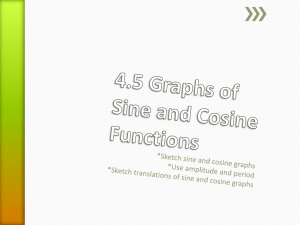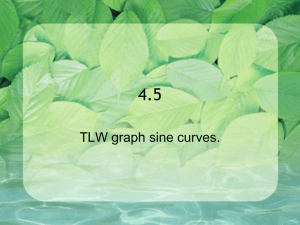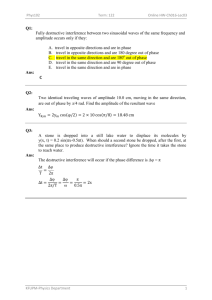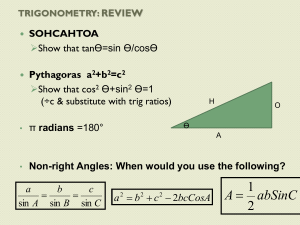Lesson 6 - 3: Dilatations of Sinusoidal Functions
advertisement
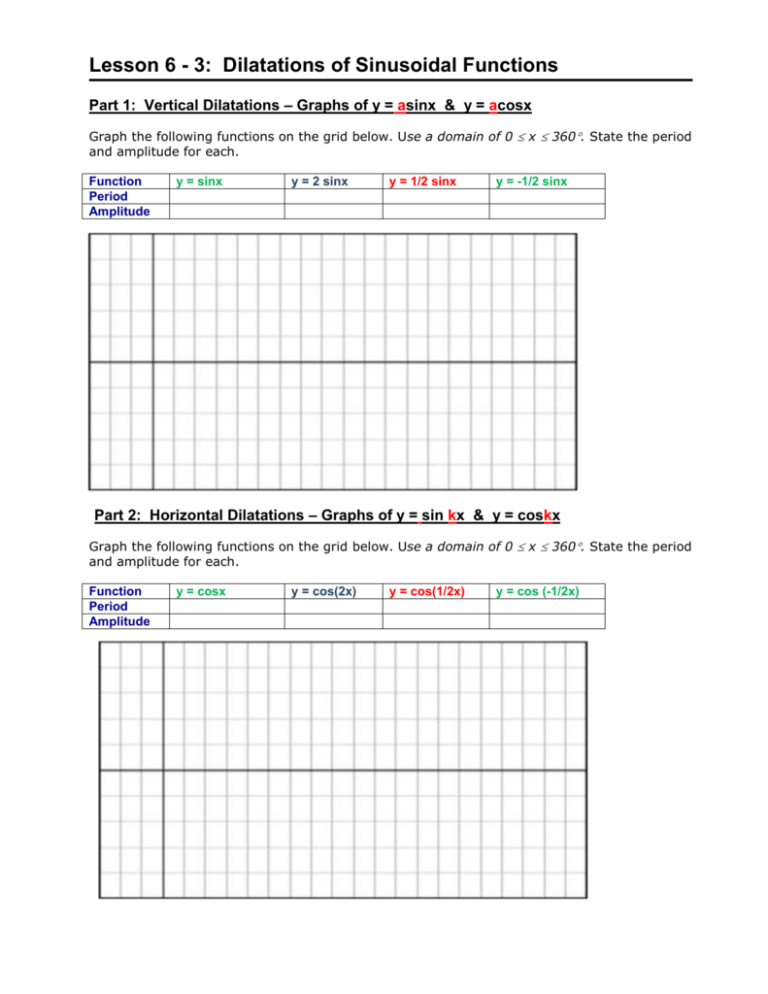
Lesson 6 - 3: Dilatations of Sinusoidal Functions Part 1: Vertical Dilatations – Graphs of y = asinx & y = acosx Graph the following functions on the grid below. Use a domain of 0 x 360. State the period and amplitude for each. Function Period Amplitude y = sinx y = 2 sinx y = 1/2 sinx y = -1/2 sinx Part 2: Horizontal Dilatations – Graphs of y = sin kx & y = coskx Graph the following functions on the grid below. Use a domain of 0 x 360. State the period and amplitude for each. Function Period Amplitude y = cosx y = cos(2x) y = cos(1/2x) y = cos (-1/2x) Lesson 6 - 3: Dilatations of Sinusoidal Functions y = asin(kx) and y=acos(kx) Dilatations are applied to sinusoidal functions in the same way they are applied to other functions. Consider the effects of the parameters “a” and “k” on y=sinx and y=cosx . Part 1: Vertical Dilatations – Graphs of y = asinx & y = acosx Graph the following functions on the grid below. Use a domain of 0 x 360. Describe the transformation and then state the period and amplitude for each. 𝟏 𝟏 y = sinx, y = 2sinx, y = 𝟐 sinx, y = - 𝟐 sinx Function y = sinx y = 2 sinx 𝟏 𝟏 Transformation None Vertical stretch by factor of 2 y = 𝟐 sinx Vertical compression by factor of 0.5 y = - 𝟐 sinx Vertical stretch by factor of 2 and reflection in x-axis Period 360° 360° 360° 360° Amplitude 1 2 0.5 0.5 Note: The vertical dilatation factor “a” gives the amplitude of the function: │ a│ = amplitude Part 2: Horizontal Dilatations – Graphs of y = sin kx & y = coskx Graph the following functions on the grid below. Use a domain of 0 x 360. Describe the transformation and then state the period and amplitude for each. 𝟏 𝟏 y = cosx, y = cos(2x), y = cos (𝟐 𝒙), y = cos (− 𝟐 𝒙) Function y = cosx y = cos(2x) 𝟏 y = cos(𝟐 𝒙) 𝟏 y = cos (− 𝟐 𝒙) Transformation None Horizontal Horizontal horizontal stretch compression by stretch by factor by factor of 2 and factor of 0.5 of 2 reflection in y-axis Period 360° 180° 720° 720° Amplitude 1 1 1 1 Note: The horizontal dilatation factor “k” is used to calculate the period of the function: Period = 360° │k│ Lesson 6 - 3: Dilatations of Sinusoidal Functions y = asin(kx) and y=acos(kx) Dilatations are applied to sinusoidal functions in the same way they are applied to other functions. Consider the effect of the parameters “a” and “k” on y=sinx and y=cosx . Recall: Function Transformation y = asin x y = acos x If a > 1 graph is If 0 < If y = sin kx y = cos kx If a k a < 1 graph is by a factor of a < 0 graph is in the x-axis >1 graph is If 0< If by a factor of a Effect on key points Multiply y-values by “ ” by a factor of 1/k k <1 graph is by a factor of 1/k k < 0 graph is Divide x-values by “ ” in the y-axis The amplitude of each function is The period of each function is P = . . Graphing Using the Five Point Method To sketch sine and cosine functions it is convenient to use the five key points of one cycle. These five points are: 1. Zero 2. Maximum 3. Zero 4. Minimum 5. Zero Recall: The 5 key points for the sine and cosine function are: ( , sin ) (00, ) 0 (90 , ) 0 (180 , ) 0 (270 , ) (3600, ) ( , cos ) (00, ) 0 (90 , ) 0 (180 , ) 0 (270 , ) (3600, ) Each of the five key points are evenly spaced along the x-axis and divide the function into 4 quarters or INTERVALS. The length of one interval, I = . Ex. 1a): Graph one cycle of sine function that has amplitude of 2 and a period of 720°, θ≥0°. b) Write the equation of the sine function. c) State the domain and range of the function. Ex. 2: Sketch one cycle of y= 1 cos 2 x , starting at (0, 0), x 0. State the domain and range of one 3 cycle. Ex. 3: Write the equation for the cosine function with amplitude of 7 and a period of 1080°. Ex. 4: Determine the equation of the sine function below: 1 9 0 o 1 8 0o 2 7 0o -1 Homefun: Handout 360° Exit Ticket Sketch the graph of f(x) = 3sin[2x] 6 - 4 Using Transformations to Sketch Graphs of Sinusoidal Functions Unit 6: Sinusoidal Functions -vertical translation; -affects eq. of axis, max. & min. values, range -no effect on period, amplitude or domain _____________________ -a maximum occurs at 90o _____________________ -horizontal translation -no effect on period, amplitude eq. of axis, domain or range _____________________ -vertical stretch or compression -affects max & min, amplitude, and range -no effect on period or domain _____________________ -a minimum occurs at 180o _____________________ -horizontal stretch or compression -affects period _____________________ -no effect on amplitude, eq. of axis, max. & min., domain, and range Combinations of Transformations: Graphing y = a sin [k(x – d)] + c & y = a cos[k(x – d)] + c Perform transformations of trigonometric functions in the following order: 1. 2. 3. State: 1. 2. 3. 4. 5. Pg, 379 #1-3; Pg 383 #1-2, (3calculators), 4ace, 5, (6-7)ace
